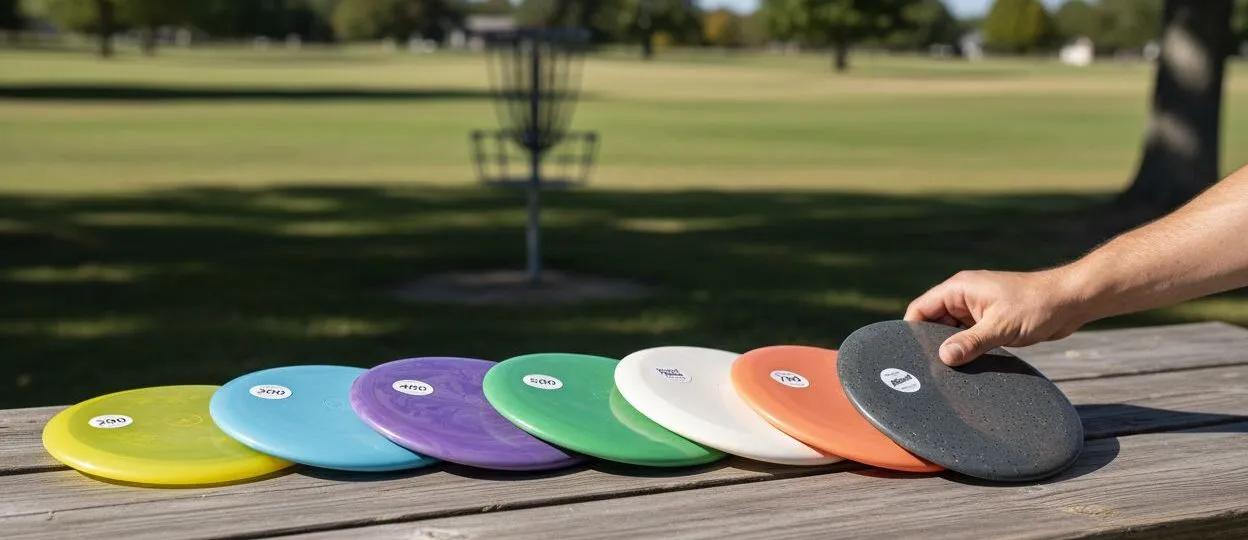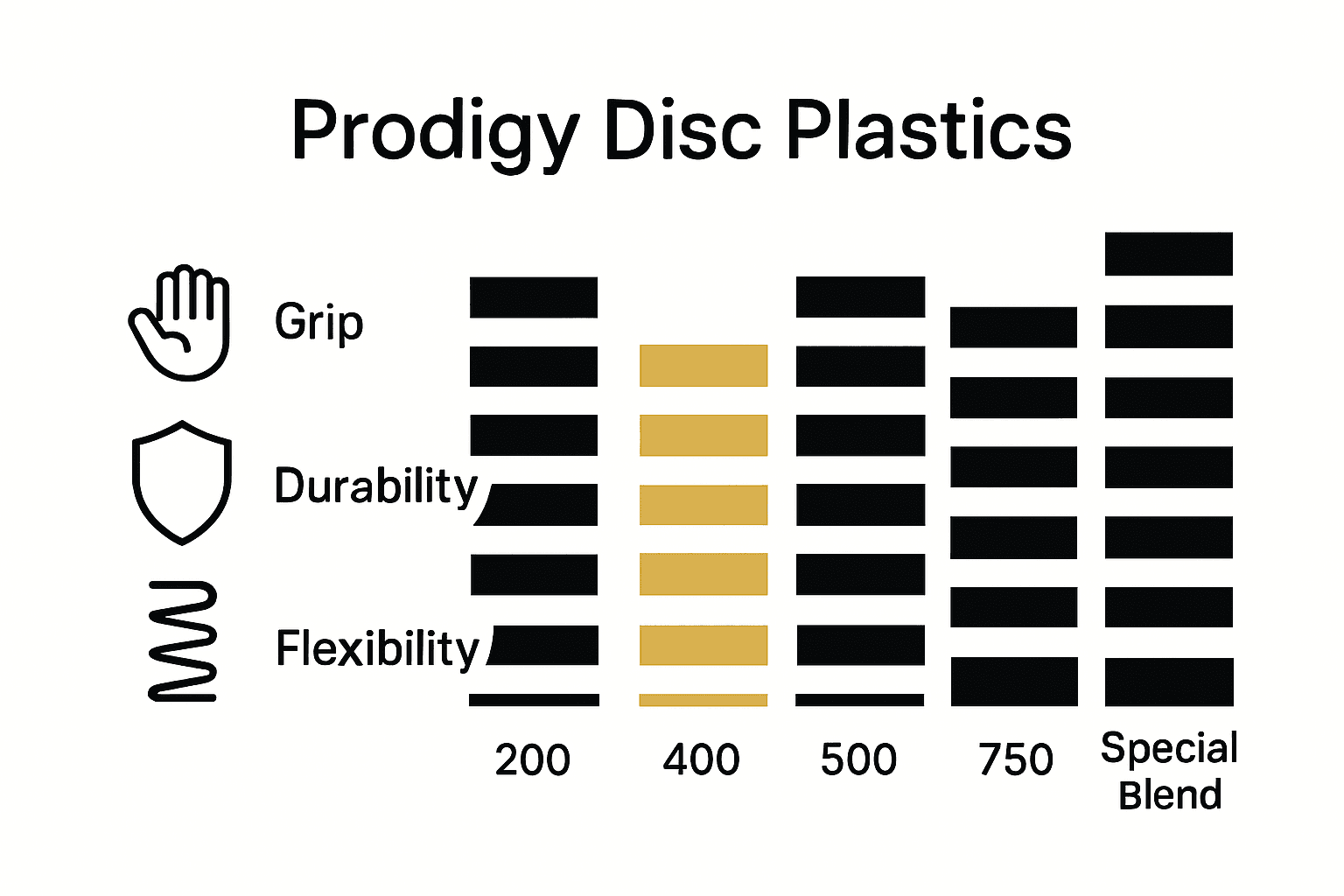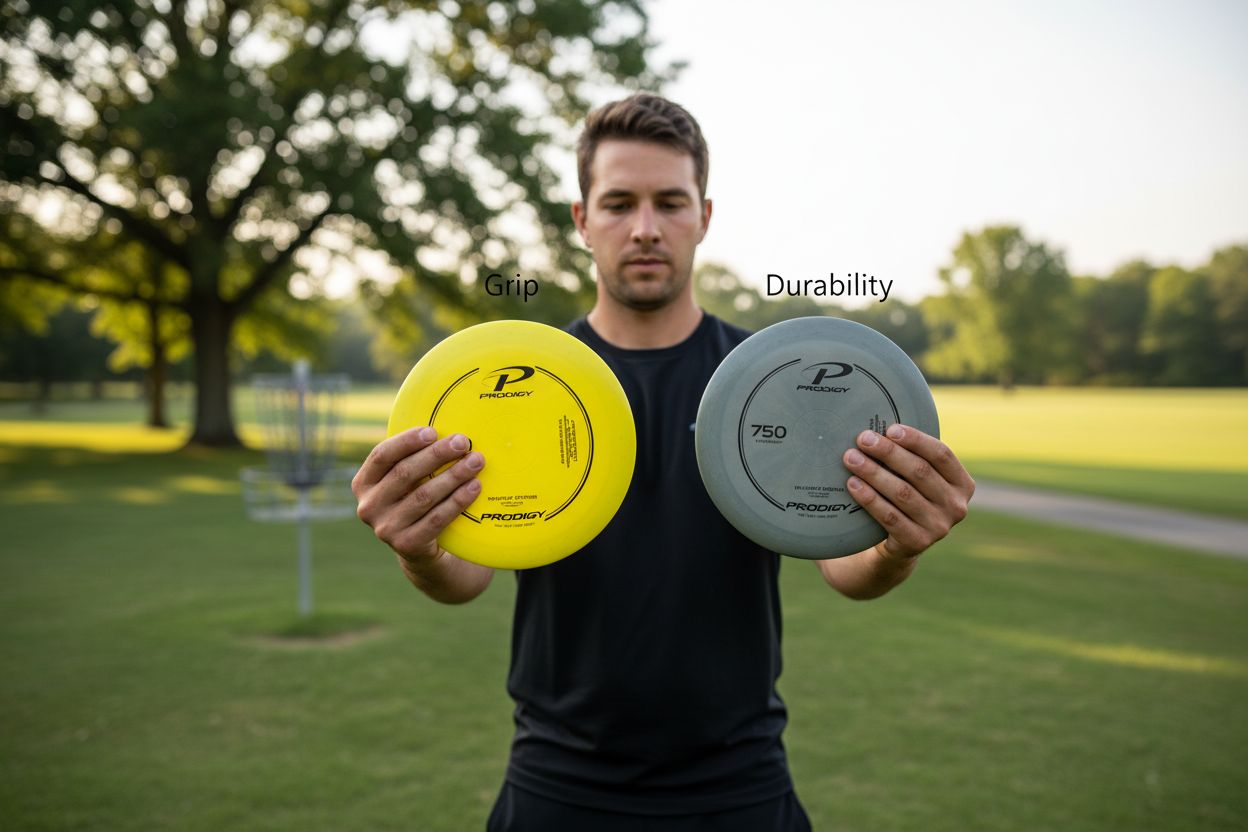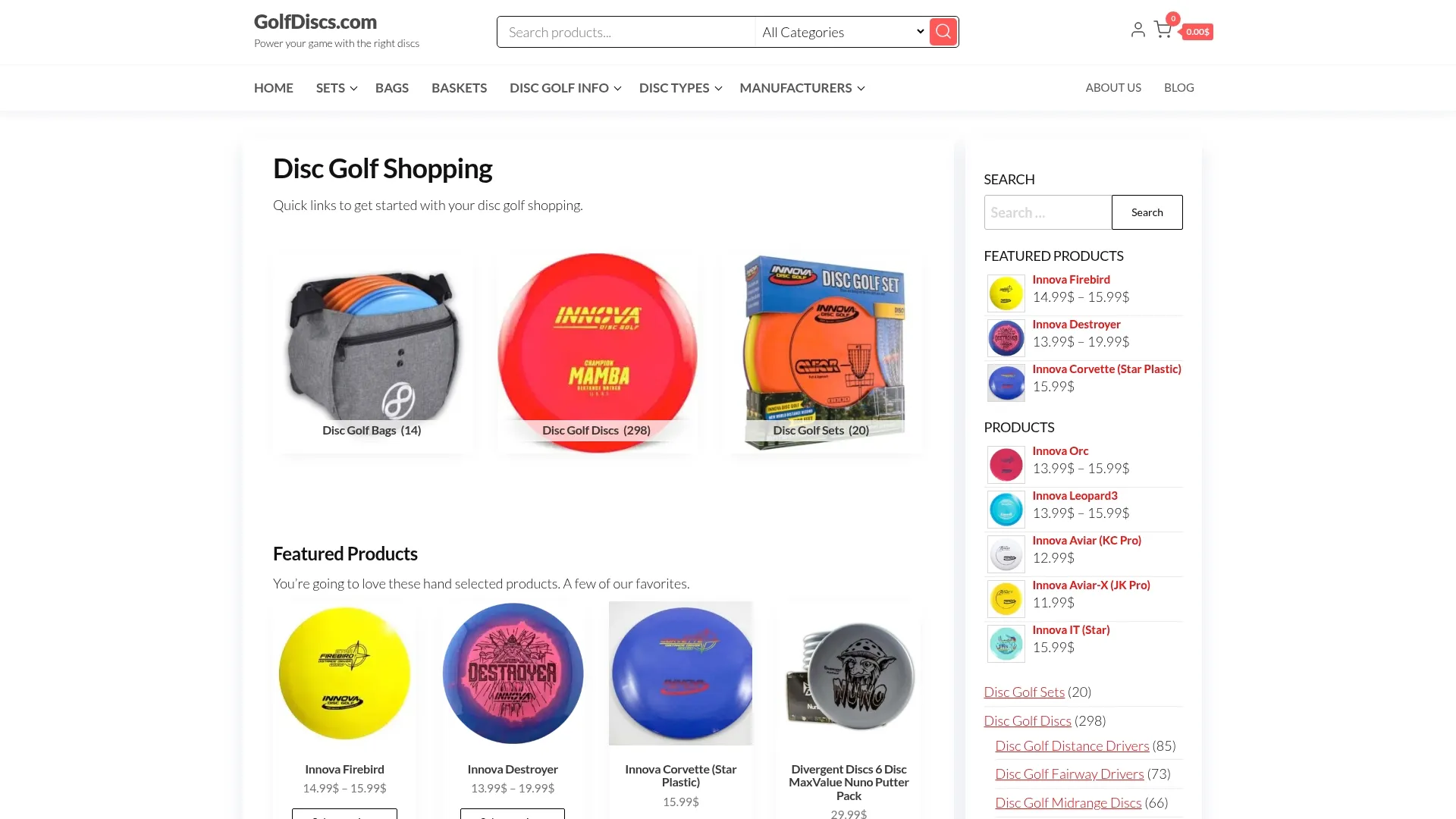
Prodigy Discs Plastic Types: Complete Breakdown Guide
Did you know that Prodigy Discs offers seven different plastic blends designed for all types of disc golfers? Choosing the right plastic can mean the difference between a disc that feels perfect in your hand or one that falls short in tough conditions. With so many options and features, understanding each plastic type gives you the advantage to pick discs that match your style, skill, and even the weather on the course.
Table of Contents
- What Are Prodigy Discs Plastic Types?
- Major Prodigy Plastic Blends Explained
- Durability, Grip, And Flight Performance
- Choosing Plastic Types For Your Game
- Common Mistakes And Care Tips
Key Takeaways
| Point | Details |
|---|---|
| Diverse Plastic Types | Prodigy Discs offers various plastic types (200, 300, 400, 500, and 750 series) tailored to different performance needs, enabling players to choose based on skill level and conditions. |
| Performance Characteristics | Each plastic type varies in grip, durability, and flexibility, impacting disc performance and suitability for different throwing techniques and playing environments. |
| Maintenance Matters | Proper care, including temperature control and cleaning practices, is crucial for preserving the integrity and performance of Prodigy discs. |
| Beginner to Advanced Options | Beginners should start with the forgiving 200 Plastic, while advanced players may prefer 400 and 750 series for superior performance in challenging conditions. |
What Are Prodigy Discs Plastic Types?
Prodigy Discs offers a diverse lineup of plastic types engineered to meet the nuanced performance demands of disc golf players. According to their official sources, their plastic range includes 200, 300, 400, 500, and 750 series, each designed with specific characteristics to enhance player experience and disc performance.
The plastic types vary significantly in their core properties. The 300 series, for instance, provides a balanced blend of durability and grip, making it versatile for multiple playing conditions. In contrast, the 400 and 500 series offer increased durability and stability, ideal for players seeking consistent flight characteristics. Specialized variants like 300 Soft, 300 Firm, and 400G further expand the range, allowing players to select plastics that match their throwing style and environmental conditions.
Prodigy’s plastic innovation doesn’t stop there. Their Special Blend and ReBlend plastics represent advanced material engineering, providing unique performance characteristics. These specialized plastics cater to players looking for specific tactile sensations, enhanced grip, or optimized weight distribution. Whether you’re a beginner seeking forgiving disc behavior or a professional demanding precise flight performance, Prodigy’s comprehensive plastic lineup ensures there’s a disc tailored to your specific needs.
By understanding these plastic types, disc golfers can make more informed equipment choices. Each plastic type offers a unique combination of grip, durability, and flexibility, allowing players to customize their disc selection based on their skill level, playing environment, and personal preferences.

Here’s how Prodigy plastic types compare on key performance characteristics:
| Plastic Type | Grip | Durability | Flexibility |
|---|---|---|---|
| 200 Series | High | Low | Very Flexible |
| 300 Series 300 Soft 300 Firm |
Very High | Moderate | Flexible Softer or Firmer options |
| 400 Series 400G |
High | High | Moderate Slightly Stiffer |
| 500 Series | Moderate | Very High | Stiff |
| 750 Series | Moderate | Maximum | Very Stiff |
| Special Blend ReBlend |
Varies | High | Varies |
Major Prodigy Plastic Blends Explained
Prodigy Discs offers an impressive range of plastic blends designed to meet the diverse needs of disc golfers at all skill levels. According to Prodigy’s official sources, their plastic lineup includes seven distinct types, each engineered with specific performance characteristics. Exploring disc golf plastic types can help players understand the nuanced differences between these blends.
At the entry level, the 200 Plastic provides an affordable and forgiving option for new players. Moving up, the 300 Plastic series offers exceptional grip and is particularly popular for putters and midrange discs. For players seeking premium performance, the 400 Plastic delivers excellent durability and tactile feedback. The 500 Plastic stands out with its pearlescent finish and stiffer feel, while the 750 Plastic represents the pinnacle of durability and firmness in Prodigy’s lineup.
Beyond these core blends, Prodigy continues to innovate with specialized variants. The 400G and Special Blend plastics provide unique characteristics that cater to specific playing styles and environmental conditions. These advanced formulations allow players to fine-tune their disc selection, balancing factors like flexibility, grip, and longevity to match their individual throwing techniques.
Ultimately, understanding Prodigy’s plastic types empowers disc golfers to make informed equipment choices. Whether you’re a beginner looking for a forgiving disc or an experienced player seeking precise performance, Prodigy’s comprehensive plastic range offers a solution for every skill level and playing style.
Durability, Grip, and Flight Performance
Prodigy Discs has meticulously engineered its plastic types to optimize the three critical aspects of disc performance: durability, grip, and flight characteristics. Understanding disc golf flight numbers becomes crucial when evaluating how different plastic types impact a disc’s overall performance.
According to Prodigy’s official sources, durability varies significantly across their plastic ranges. The 400 Plastic stands out for its exceptional durability and grip, making it ideal for players who frequently encounter challenging weather conditions. In contrast, the 300 Plastic series is designed to break in gradually, which subtly transforms the disc’s flight characteristics over time. This gradual wear allows players to experience a nuanced evolution in their disc’s performance.

Grip is another critical factor where Prodigy excels. The 300 Plastic blend, particularly popular among putters and midrange disc players, offers an optimal tactile experience. Its carefully developed composition ensures consistent grip across different environmental conditions. Advanced players appreciate how the plastic’s grip can influence release consistency and overall throwing precision.
Ultimately, Prodigy’s approach to plastic design demonstrates a sophisticated understanding of disc golf dynamics. By carefully balancing durability, grip, and flight performance, they provide disc golfers with tools that can adapt and perform across various playing styles and environmental challenges. Whether you’re a beginner seeking forgiveness or a professional demanding precise performance, Prodigy’s plastic types offer a tailored solution for every skill level.
Choosing Plastic Types for Your Game
Selecting the right Prodigy plastic type is a nuanced decision that can significantly impact your disc golf performance. Understanding disc golf plastic types provides critical insights into making an informed choice that matches your skill level and playing style.
For beginners, the 200 Plastic offers an excellent starting point. Its forgiving nature and easy break-in characteristics make it ideal for players learning fundamental techniques. As players progress, the 300 Plastic becomes increasingly attractive, providing a balanced blend of grip and durability that suits midrange and putter shots. Advanced players often gravitate towards the 400 and 750 Plastics, which deliver superior durability and consistent performance in challenging conditions.
Your playing environment and personal throwing style should guide your plastic selection. Players seeking maximum grip might prefer the tackier 300 Plastic, while those dealing with rough terrain or frequent play will appreciate the resilience of 500 and 750 Plastics. Each plastic type introduces subtle variations in flight characteristics, grip, and wear resistance that can fine-tune your disc performance.
Ultimately, the best plastic type is the one that feels most comfortable and enhances your natural throwing technique. Experimenting with different Prodigy plastic blends allows you to discover the perfect match for your game, transforming your disc golf experience from good to exceptional.
Common Mistakes and Care Tips
Prodigy disc golfers often overlook critical maintenance practices that can significantly impact their discs’ performance and longevity. Understanding disc golf disc stability provides valuable context for preserving your disc’s essential characteristics through proper care.
Temperature exposure is one of the most common and overlooked factors in disc maintenance. Extreme heat or cold can dramatically alter the plastic’s molecular structure, affecting grip, flexibility, and flight characteristics. Avoid leaving discs in direct sunlight, hot car interiors, or freezing environments. Proper storage means keeping your discs in a cool, dry place with consistent temperature, ideally between 50-75 degrees Fahrenheit.
Cleaning and handling are equally crucial for maintaining your Prodigy discs. Use mild soap and lukewarm water to remove dirt and debris, avoiding harsh chemicals that could degrade the plastic. Microfiber towels work best for drying, preventing scratches that might impact the disc’s aerodynamic properties. When transporting discs, invest in a quality disc golf bag with individual compartments to minimize contact and potential damage between discs.
Ultimately, treating your Prodigy discs with care is an investment in your disc golf performance. Regular maintenance not only preserves the disc’s physical condition but also ensures consistent flight characteristics and extends the lifespan of your favorite throwing companions. A little prevention goes a long way in maintaining the precision and reliability of your disc golf equipment.
Find Your Perfect Prodigy Disc Plastic at GolfDiscs.com
Choosing the right plastic type is key to unlocking your best game. This article highlights common challenges disc golfers face like balancing grip, durability, and flight performance across Prodigy’s diverse plastic blends. Whether you struggle with disc wear, inconsistent grip in different weather, or just want discs that feel tailor-made to your style, understanding these plastics is the first step to playing confidently.

Don’t let uncertainty keep you from elevating your disc golf experience. Explore our wide selection of Prodigy discs and plastic types at GolfDiscs.com. Here you can find detailed descriptions to match your skill level and playing conditions perfectly. Act now to get discs designed for durability, grip, and precision flying today. Make your next throw count with the right plastic from GolfDiscs.com and learn more about understanding disc golf plastic types and does frisbee golf plastic type really matter.
Frequently Asked Questions
What are the different types of Prodigy Discs plastics?
Prodigy Discs offers a range of plastic types, including the 200, 300, 400, 500, and 750 series. Each type is designed with specific characteristics to enhance performance, such as grip, durability, and flexibility.
How does the grip of Prodigy plastics compare?
The grip varies across the plastic types, with the 300 series providing a very high grip ideal for putters and midrange disc players, while the 500 series offers moderate grip. The 200 series has high grip but is very flexible.
What factors should I consider when choosing a Prodigy plastic type?
When choosing Prodigy plastic, consider your skill level, playing style, and environmental conditions. Beginners may prefer the forgiving 200 plastic, while advanced players might opt for the durability and consistency of the 400 or 750 plastics.
How can I maintain my Prodigy discs for optimal performance?
To maintain your Prodigy discs, store them in a cool, dry place, avoid extreme temperatures, and clean them with mild soap and lukewarm water. Proper handling and storage can significantly extend the discs’ lifespan and performance.
